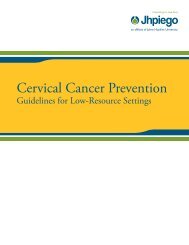Manual for Male Circumcision under Local Anaesthesia
Manual for Male Circumcision under Local Anaesthesia
Manual for Male Circumcision under Local Anaesthesia
You also want an ePaper? Increase the reach of your titles
YUMPU automatically turns print PDFs into web optimized ePapers that Google loves.
<strong>Male</strong> circumcision <strong>under</strong> local anaesthesia<br />
Version 3.1 (Dec09)<br />
If the machine fails to respond when the surgeon activates the current<br />
or there is no obvious and immediate visual evidence of coagulation,<br />
the surgeon should immediately stop applying current and check all<br />
connections. If current continues to flow, burns may occur where<br />
resistance is greatest, most commonly where the grounding plate is in<br />
contact with the body, or where the body is in contact with metal. In<br />
rare circumstances the burn may occur elsewhere in the body.<br />
Monopolar diathermy should not be used <strong>for</strong> infant circumcision<br />
because the point of greatest electrical resistance may be at the base<br />
of the penis with risk of coagulation and loss of the whole penis.<br />
Further technical description of the current types is beyond the scope<br />
of this manual but the circumcision surgeon should be aware that<br />
many diathermy machines have different settings <strong>for</strong> coagulation or<br />
cutting currents. Only the <strong>for</strong>mer should be used <strong>for</strong> haemostasis.<br />
Diathermy technique: When using diathermy, the surgeon should<br />
apply the <strong>for</strong>ceps as precisely as possible. The best results will be<br />
obtained if the blood vessel is grasped between the diathermy prongs<br />
with minimal other tissue, and the current activated <strong>for</strong> the shortest<br />
time required to ensure haemostasis. If too much tissue is grasped,<br />
diathermy will not stop the bleeding because the heat is too diffuse.<br />
Prolonged diathermy causing large black burns should be avoided as<br />
these may increase the risk of infection, post operative pain or scar<br />
tissue <strong>for</strong>mation. Particular care must be taken near the frenulum<br />
because there is a risk of burning through to the urethra which is near<br />
to the surface and creating a fistula. Diathermy should also be used<br />
with caution close to the skin and mucosal edges as transmitted heat<br />
may cause burns. Diathermy can be used to stop bleeding from small<br />
blood vessels, but it is safer to apply an artery <strong>for</strong>ceps and tie or<br />
<strong>under</strong>-run larger vessels as described above.<br />
Suture material<br />
Suture size is a compromise between ensuring adequate tensile<br />
strength and keeping the amount of <strong>for</strong>eign material to a minimum.<br />
Larger suture sizes produce a more unsightly scar, and small lumps<br />
can persist when large-size sutures have been used to tie the blood<br />
vessels. The preferred suture size <strong>for</strong> adult male circumcision is 3-0 or<br />
4-0 chromic gut or vicryl rapide. Vicryl rapide is more expensive than<br />
chromic gut. The suture may be mounted on a taper-cut, round-bodied<br />
or reverse-cutting needle, according to the surgeon’s preference. The<br />
taper-cut needle passes more easily through the skin, but easily tears<br />
the skin on the inner aspect at the corona.<br />
Suturing<br />
The following are the basic suturing techniques:<br />
Simple interrupted suture. This is the simplest type of stitch and<br />
results in good apposition. The point of the needle should pass through<br />
the skin at 90 degrees to the skin surface and exit at the same angle<br />
(Fig. 5.5). The nearer to the skin edge the needle goes in, the better<br />
the skin edge apposition but the higher the risk of the stitch cutting out.<br />
If the stitches are placed at a greater distance from the wound edge,<br />
Surgical procedures <strong>for</strong> adults and adolescents Chapter 5-5
















